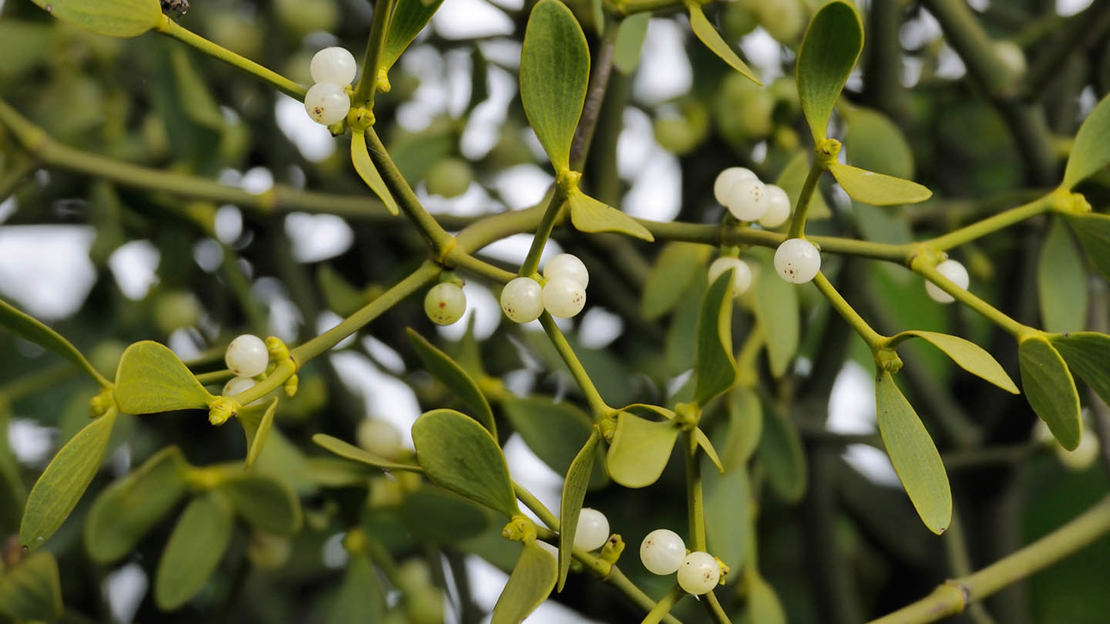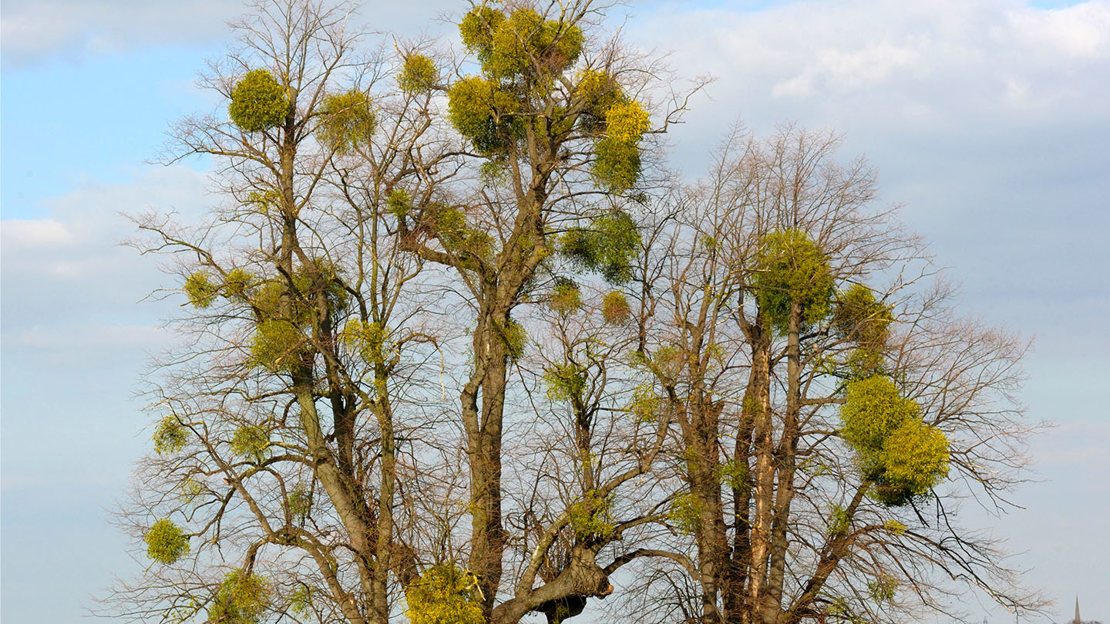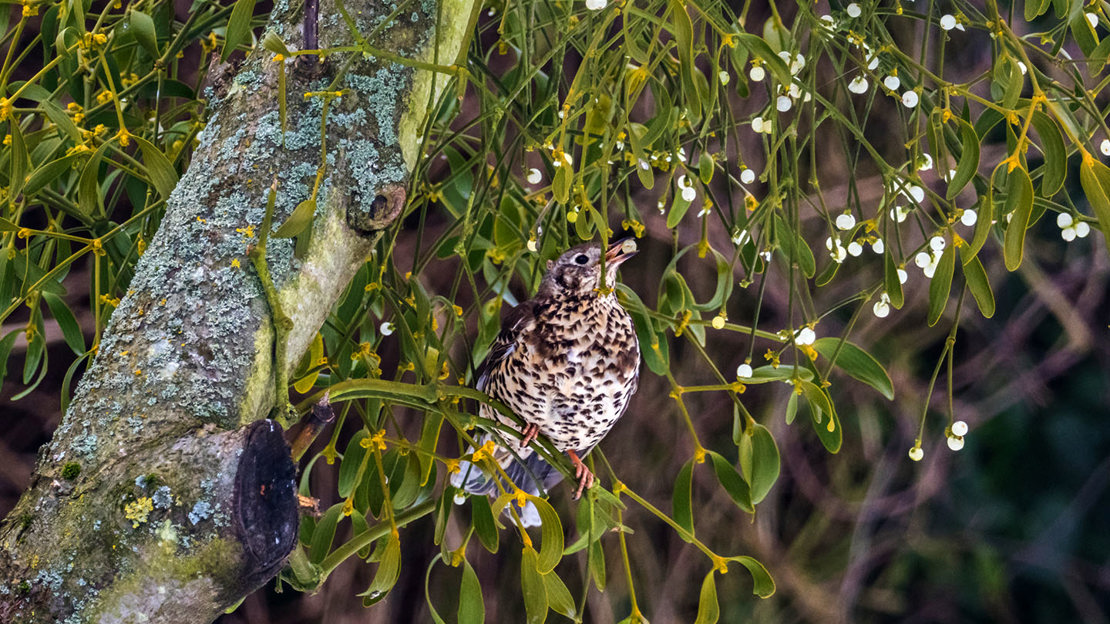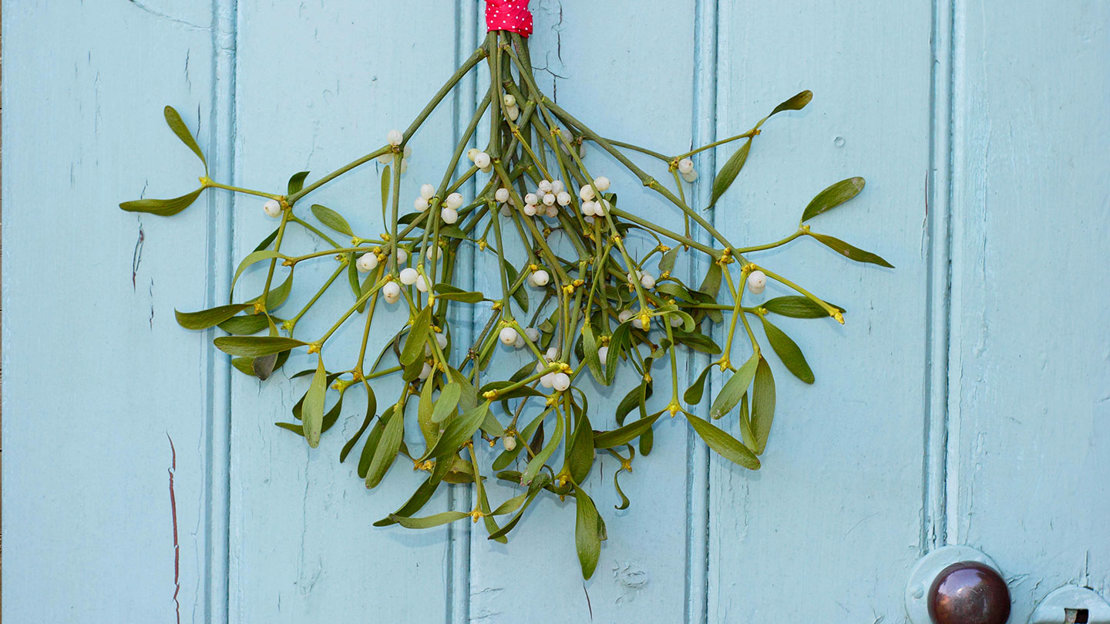Looking for that perfect Christmas gift?
From greetings cards and calendars to a range of gift ideas, we've got loads of ways to make the season special. And every purchase helps woods and trees too.
Shop now
Digital Content Manager
Mistletoe is a familiar Christmas staple, soaked in folklore and midwinter tradition. But where does it grow and how can you find it in the wild?

Mistletoe is an evergreen plant with distinctive forked branches and pairs of symmetrical evergreen leaves. In winter it produces clusters of pearlescent white berries which are favourites with hungry birds such as thrushes.
The plant is hemiparasitic, which means it takes some of its food from another plant. It grows on the branches of trees, pulling water and nutrients from its host, while its green leaves also photosynthesise.
There are more than 900 species of mistletoe around the world. The only species native to the UK is European mistletoe (Viscum album) which has the widest host range of all its relatives.
Mistletoe is often confused with holly, but there are key differences to note. Perhaps the most distinctive difference is the colour of their berries – mistletoe has white berries whereas holly features red berries. The shape of the leaves differs too, the leaves on mistletoe are spoon-shaped whereas holly has spiney, glossy-green leaves. Another important difference between the two lies in how they grow. Mistletoe is hemiparasitic and grows on trees, whereas holly grows as a shrub or small tree with its own roots in the ground.

Mistletoe grows on the branches of trees but despite that, it is not generally found in a woodland setting, preferring hosts in open situations with plenty of light. You’re more likely to see it in gardens, orchards, parkland and even churchyards. This means that mistletoe would have been less abundant in ancient times when woodland was more typical.
So, what type of trees does mistletoe grow on? Mistletoe can be found on the branches of trees such as hawthorn, poplar and lime, although in the UK the most common hosts are cultivated apple trees.
It's commonly found in Wales, the West Midlands and the South of England, with particularly large populations in Gwent, Herefordshire, Worcestershire, Gloucestershire and Somerset. It was once thought that this clustering was due to the number of apple orchards in these regions, but this has been proven incorrect as orchards are found in locations where mistletoe is absent.
Mistletoe is widely scattered elsewhere in England and Wales, but is rarely seen in eastern and northern England and Scotland.

In recent years, mistletoe's range in the UK has begun to expand, particularly into eastern areas of England. This may be due in part to an influx of continental blackcaps from Germany that have started overwintering in Britain, with many thousands now spending their winters here.
Blackcaps are migratory warblers that are becoming regular winter visitors to our bird tables. Berries, including those of mistletoe, are an essential part of their diet. On eating the white flesh of the mistletoe berry, the birds wipe their bills on twigs and branches, leaving behind the seed. If the seed is deposited on a host tree and manages to take hold, a mistletoe plant might germinate on the branch. It seems that blackcaps are more efficient at spreading mistletoe seeds than other birds, such as the mistle thrush, which also feed on the berries.
You should always obtain the landowner's permission before gathering mistletoe from the wild. It is also important not to take too much. Our foraging guidelines offer advice.
The mistletoe marble moth (Celypha woodiana) needs this unusual plant to complete its life cycle. Its larvae overwinter in small mines chewed into the leaves of the plant, which become inflated by late spring when the larvae are fully grown. The larvae then emerge from the mines and pupate in a cocoon under bark or among lichens on the host tree.
The mistletoe marble moth is a priority species for conservation in the UK. It is only found in six English counties, and populations are declining. It is thought that the amount of mistletoe harvested in these counties poses a threat to the future of this already rare species.
Yes, all parts of mistletoe are poisonous. It contains phoratoxin which is a toxic protein that can cause serious health issues if ingested. Symptoms include stomach and intestinal issues, blurred vision and drowsiness. It is therefore important to keep mistletoe out of reach of children and pets, and to seek medical attention if ingested.

Mistletoe appears a few times across different folklores. In Norse legend, when Balder was killed by mistletoe, the gods made the mistletoe promise to forever be devoted to acts of happiness and usefulness. In Greek mythology, heroes with mistletoe were granted passage to the underworld. The Druids revered mistletoe as a powerful talisman, believing it could ward off evil spirits and heal ailments. This symbolism continued into the Middle Ages, where it was linked to fertility and vitality.
The well-known Christmas traditions involving mistletoe are relatively recent in origin. It is believed that the tradition of hanging a mistletoe under doorways and kissing under it only became established as part of Christmas celebrations by the 18th and 19th centuries. However, the true origin of kissing under the mistletoe remains elusive, likely because the plant holds significance in various cultures. Some trace the custom to ancient folklore, while others believe it stems from the Roman festival of Saturnalia, which took place around Christmas time. During Saturnalia, people decorated their homes with greenery, including mistletoe, and exchanged gifts.
From greetings cards and calendars to a range of gift ideas, we've got loads of ways to make the season special. And every purchase helps woods and trees too.
Shop now